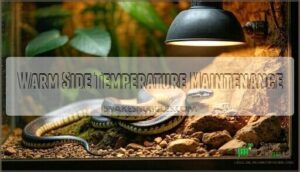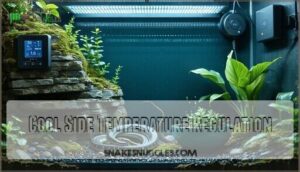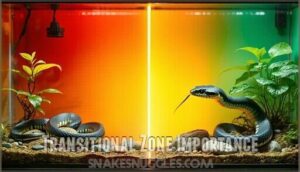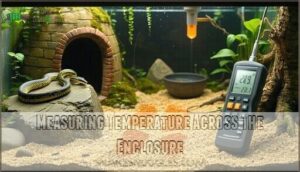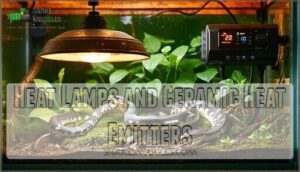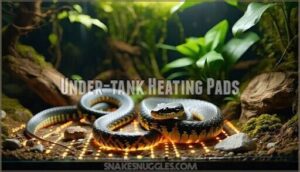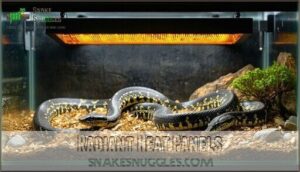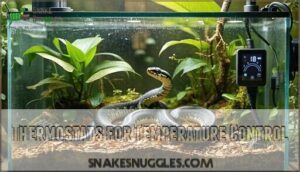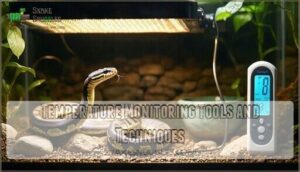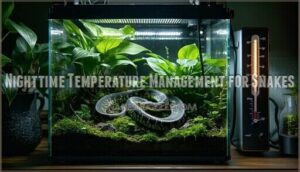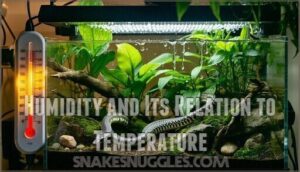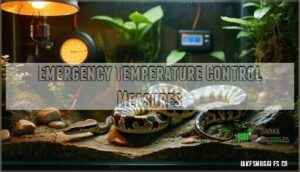This site is supported by our readers. We may earn a commission, at no cost to you, if you purchase through links.
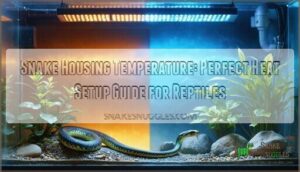
This temperature gradient lets your snake thermoregulate naturally, just like they’d do in the wild by moving between sun and shade.
Most species thrive with basking spots hitting 90-95°F during the day, while nighttime temps can drop about 5-10 degrees safely.
Different snake species have unique needs though – ball pythons prefer it toasty while corn snakes tolerate cooler conditions.
Getting the right heating equipment and monitoring tools makes all the difference between a thriving snake and a stressed one.
Table Of Contents
- Key Takeaways
- Optimal Temperature Range for Snake Enclosures
- Creating a Proper Heat Gradient
- Heating Equipment for Snake Habitats
- Temperature Monitoring Tools and Techniques
- Thermal Hiding Spots for Snakes
- Seasonal Temperature Adjustments for Snake Enclosures
- Nighttime Temperature Management for Snakes
- Humidity and Its Relation to Temperature
- Emergency Temperature Control Measures
- Frequently Asked Questions (FAQs)
- Is a snake cage too hot?
- How do snakes control temperature?
- Do snakes need a heat source?
- What temperature does a snake need?
- How do you keep a snake warm?
- What temperature should a snake shed be?
- At what temperature is it too cold for snakes?
- Is 80 degrees too hot for a snake?
- How do I know if my snake is warm enough?
- What temperature should a snake enclosure be?
- Conclusion
Key Takeaways
- Create a proper temperature gradient with a warm side at 80-85°F and a cool side at 75°F, plus basking spots reaching 90-95°F, to let your snake thermoregulate naturally.
- Use reliable heating equipment with thermostats: heat lamps, ceramic emitters, or under-tank pads paired with digital thermometers and thermostat controls prevent dangerous temperature spikes.
- Research your specific species’ needs, since ball pythons prefer warmer conditions around 90-95°F, while corn snakes tolerate cooler temperatures, and adjust accordingly.
- Monitor temperatures daily and prepare for emergencies by checking both warm and cool zones regularly, plus having backup heating solutions ready for power outages or equipment failures.
Optimal Temperature Range for Snake Enclosures
You’ll need to maintain precise temperature ranges to keep your snake healthy and comfortable in its enclosure.
Getting the temperatures right means creating a proper heat gradient that allows your snake to thermoregulate naturally, just like it would in the wild.
Perfect temperatures create the foundation for your snake’s healthy, stress-free life.
Daytime Basking Temperatures
Your snake typically needs basking spots around 85-95°F during daylight hours.
Heat sources like heat lamps create these essential thermal gradients, with most species thriving at 90-95°F basking temperatures.
This warm zone supports digestion and shedding—your snake’s daily vitamin dose!
Thermostats prevent overheating while maintaining proper temperature ranges for optimal snake comfort.
Maintaining the right temperature gradient is vital for your snake’s overall health and well-being.
Nighttime Temperature Requirements
Most reptiles need nocturnal drops in temperature to maintain healthy thermal cycling.
You’ll want to keep nighttime temperatures above 65°F while allowing natural cool downs that mimic their wild habitat.
Smart thermostat controls make overnight heating management effortless.
- Maintain minimum temps – Never let nighttime temperature requirements drop below 65°F
- Create thermal cycling – Allow 5-10°F temperature drops for natural circadian rhythms
- Use overnight heating – Heat mats provide consistent warmth without disrupting sleep cycles
Temperature Gradient Importance
Creating thermal balance transforms your enclosure into a reptile paradise.
Temperature gradients aren’t just fancy—they’re survival tools that enable proper thermoregulation.
Your snake chooses ideal zones for digesting, basking, or cooling down, mimicking natural heat distribution patterns.
| Zone | Temperature | Purpose |
|---|---|---|
| Basking | 90-95°F | Active warming |
| Warm side | 80-85°F | General activity |
| Cool side | 70-75°F | Temperature regulation |
| Hide boxes | 75-85°F | Secure thermoregulation |
Species-specific Temperature Needs
Your snake’s homeland dictates its temperature preferences just like your thermostat settings reflect your comfort zone.
Ball Python temperature requirements hover around 90-95°F basking spots, while Corn Snake ideal temperature range spans 88-90°F.
Boa Constrictor temperature ranges reach 86-90°F, and King Snake temperature preferences stay at 85-90°F.
Understanding these species-specific temperature needs prevents health issues.
Ball pythons thrive with a proper thermal gradient setup to meet their temperature requirements.
- Your Ball Python’s African roots crave that tropical warmth
- Corn Snake temperature requirements mirror temperate climates
- Boa Constrictor snake temperature preferences reflect rainforest origins
- King Snake temperature ranges suit their adaptable nature
- Garter Snake needs cooler conditions than most species
Creating a Proper Heat Gradient
You’ll need to establish a proper heat gradient to keep your snake healthy and comfortable throughout its enclosure.
This thermal setup mimics natural conditions by creating distinct temperature zones that allow your snake to regulate its body temperature effectively, ensuring a comfortable environment through a proper thermal setup.
Warm Side Temperature Maintenance
The warm side of your snake’s enclosure serves as their essential basking spot, requiring precise temperature control between 80-95°F depending on species.
Heat lamps or ceramic emitters create effective thermal gradients, while your thermostat guarantees consistent warm zones.
Think of it as your snake’s personal spa retreat where they’ll spend quality time regulating their body temperature!
Cool Side Temperature Regulation
Balancing your enclosure’s cooler zones isn’t just about turning down the heat—it’s about creating the perfect thermal refuge for your snake.
Here’s your cooling game plan:
- Position cold spots away from primary heat sources
- Use thermostats to prevent temperature drops below 70°F
- Maintain proper airflow without creating drafts
- Monitor your cool end with reliable digital thermometers
Transitional Zone Importance
Between your warm and cool sides lies the transitional zone – your snake’s perfect temperature-shopping area.
This middle ground allows precise thermal gradients and gradient control, letting your pet fine-tune their body temperature throughout the day.
Without proper zone temperatures, snakes can’t achieve ideal snake comfort or handle natural temperature fluctuations effectively.
Measuring Temperature Across The Enclosure
Multiple temperature sensors create the foundation for accurate thermal zones throughout your snake’s enclosure.
Place digital thermometer probes at substrate level in both warm and cool areas, while using an infrared temperature gun for heat mapping surface temperatures.
Position thermostat probes inside warm hides for precise gradient control and effective temperature monitoring across all zones.
Maintaining a proper temperature gradient is essential for the health and well-being of your snake.
Heating Equipment for Snake Habitats
You’ll need the right heating equipment to create a proper temperature gradient in your snake’s enclosure.
The four main heating options include heat lamps, ceramic heat emitters, under-tank heating pads, and radiant heat panels, each requiring proper thermostat control for safe operation.
Heat Lamps and Ceramic Heat Emitters
Both heat lamps and ceramic heat emitters serve as essential heat sources for your snake’s thermal needs. Heat lamps provide visible light and infrared warmth, perfect for daytime basking spots, while ceramic heating elements deliver consistent heat distribution without light emission—ideal for nighttime temperature control.
Here are five key considerations for effective heating:
- Lamp Safety – Mount heat sources securely with protective guards to prevent burns
- Emitter Types – Choose ceramic heat emitters for 24-hour use, heat lamps for daytime basking
- Heat Distribution – Position equipment to create proper temperature gradients across the enclosure
- Temperature Control – Always use a thermostat to regulate heat output and prevent overheating
- Species Requirements – Match heating methods to your snake’s specific thermal preferences and habitat needs
Understanding the proper heat setup is vital for maintaining healthy conditions in snakes.
Under-tank Heating Pads
Under-tank heating pads create consistent belly heat that mimics how snakes naturally warm themselves on sun-heated rocks.
These adhesive heating systems require careful Pad Placement underneath your enclosure for ideal Heat Distribution. When selecting under-tank heating pads, consider the importance of proper tank heater systems for your snake’s habitat.
- Thermostat Settings – Always connect pads to temperature controllers preventing dangerous overheating
- Tank Insulation – Place foam boards underneath pads for better heat retention
- Pad Safety – Choose pads covering 1/3 of enclosure floor for proper gradient
- Temperature Control – Monitor probe placement inside warm hide for accurate readings
Radiant Heat Panels
Radiant heat panels offer superior heat distribution across your snake’s enclosure, creating gentle warmth without dangerous hot spots.
You’ll appreciate their energy efficiency and consistent heat output that mimics natural sunlight.
Proper panel placement above the basking area guarantees maximal temperature gradient formation.
These heating systems integrate seamlessly with thermostats for precise temperature control, making panel safety a top priority for responsible keepers.
Thermostats for Temperature Control
Perfect thermostat temperature control transforms your setup from guesswork to precision heating. These digital thermometers with temperature sensors monitor your heat sources continuously, maintaining ideal thermostat settings for consistent thermal control.
Using proper reptile thermostats is essential for maintaining the right temperature.
- Prevent dangerous temperature spikes that harm snakes
- Maintain proper temperature gradient automatically
- Enable precise heating adjustments for species needs
- Provide reliable monitoring while you’re away
Temperature Monitoring Tools and Techniques
You’ll need accurate temperature monitoring tools to maintain proper thermal conditions for your snake’s health and comfort.
Digital thermometers with probes and infrared temperature guns provide the precision required to track both ambient temperatures and specific hotspots throughout your enclosure.
Digital Thermometers and Probes
You’ll achieve accurate readings with digital thermometers and temperature sensors that outperform basic stick-on gauges.
Strategic probe placement matters—position sensors at your snake’s level, not against glass surfaces that skew readings.
| Feature | Digital Thermometer | Analog Thermometer | Stick-on Strip |
|---|---|---|---|
| Thermometer Accuracy | ±1°F precision | ±3-5°F variance | ±5-10°F error |
| Sensor Reliability | Consistent readings | Drift over time | Unreliable data |
| Digital Displays | Clear LCD readouts | Analog dial | Color-coded |
| Temperature Calibration | Simple reset process | Manual adjustment | No calibration |
Regular temperature calibration keeps your monitoring system trustworthy—test against known standards monthly for maximum sensor reliability.
For the best results, invest in a digital thermometer to guarantee accurate temperature readings.
Infrared Temperature Guns
Infrared temperature guns offer instant, non-contact temperature readings across your snake’s enclosure.
Point the laser targeting system at basking spots, hides, or substrate for immediate feedback on thermal gradients.
These devices excel at mapping heat distribution and detecting cold spots, though they measure surface temperatures rather than ambient air.
Always complement with digital thermometers for complete monitoring accuracy.
Placement of Temperature Sensors
Now that you’ve got your infrared temperature guns ready, strategic sensor placement makes all the difference in thermal mapping your snake’s habitat.
Position your temperature probes and digital thermometers where they’ll give you the most accurate readings for gradient monitoring.
Here’s your sensor placement strategy:
- Basking area: Place probes directly under heat sources to monitor hottest temperatures
- Cool side: Position sensors away from heating elements for accurate cool-zone readings
- Snake level: Mount thermometers at substrate height where your snake actually lives
- Hide boxes: Install probes inside both warm and cool hides for precise thermostat control
Reorganizing the text has improved its readability by grouping related concepts together, making it easier to follow the instructions for thermal mapping a snake’s habitat.
Frequency of Temperature Checks
Daily temperature checks keep your snake’s environment stable and your peace of mind intact. Check twice daily during setup, then once daily for established enclosures.
| Check Type | Frequency | Purpose | Tools Needed | Notes |
|---|---|---|---|---|
| Daily Checks | Morning/Evening | Routine monitoring | Digital thermometer | Record in temperature logs |
| Weekly Checks | Thorough inspection | Heat cycles verification | Infrared gun, probes | Check all zones thoroughly |
| Monthly Reviews | Full system check | Thermal monitoring accuracy | All equipment | Calibrate devices if needed |
| Seasonal Adjustments | Quarterly | Environmental changes | Multiple sensors | Adjust for weather patterns |
| Emergency Checks | As needed | Problem troubleshooting | Backup thermometers | Document any irregularities |
Temperature logs help you spot patterns and catch problems before they affect your snake’s health. Maintaining ideal temperature gradients requires understanding thermal monitoring systems to guarantee a healthy environment for your snake. This is crucial for ensuring your snake’s overall well-being and preventing potential health issues.
Thermal Hiding Spots for Snakes
Your snake needs secure hiding spots at different temperatures to regulate its body heat throughout the day.
You’ll want to provide both warm hides positioned over your heat source at 85-90°F and cool hides on the opposite end at 75-80°F.
Warm Hide Box Temperatures
Your warm hide box should reach 88-90°F to create the perfect thermal refuge for your snake. Heat retention materials like ceramic or stone work best, acting as thermal mass that maintains steady temperatures.
Position your hide box directly over the primary heat source for ideal box placement. Insulation types matter – avoid plastic that can’t hold heat effectively.
A thermostat probe inside monitors your warm hide box temperatures accurately within this critical thermal hiding spot.
Hide Box Materials that maximize heat retention:
- Ceramic tiles or stone slabs for superior thermal mass
- Thick wooden boxes with insulated walls
- Cork bark hollows that naturally retain warmth
- Heavy resin caves designed for reptile heating
- Avoid thin plastic – it won’t maintain your temperature gradient
Cool Hide Box Temperatures
Your snake’s cool hide box should maintain temperatures between 70-75°F, creating essential thermal refuges from the heat.
These cold spots aren’t just nice-to-have features – they’re vital for your snake’s health and stress management.
Position your cool boxes on the enclosure’s cool side, ensuring your temperature gradient flows naturally.
Quality hide box materials help maintain consistent temperatures, giving your snake comfortable retreat options whenever they need to chill out.
Materials for Insulated Hides
Several materials provide excellent thermal hiding spots for snakes.
Three top insulation types offer superior heat retention and concealment options:
- Cork bark – Natural thermal mass maintains stable hide box temperatures
- Ceramic hides – Dense materials for insulated hides retain warmth effectively
- Plastic containers – Affordable DIY options with good heat retention properties
These materials create ideal thermal hiding spots for snakes by providing consistent temperatures and secure concealment.
Multiple Hide Options
Beyond quality materials, providing multiple thermal hiding spots for snakes requires strategic enclosure layout that supports thermoregulation. Your serpent companion needs varied hide placement options to feel secure while maintaining proper body temperature throughout the day.
| Hide Type | Temperature Zone | Primary Function | Placement Location | Material Preference |
|---|---|---|---|---|
| Warm Hide | 85-95°F | Digestion & Activity | Basking Area | Dense, Heat-Retaining |
| Cool Hide | 70-75°F | Rest & Stress Relief | Opposite End | Breathable, Insulating |
| Humid Hide | 78-82°F | Shedding Support | Middle Zone | Moisture-Retaining |
| Secondary Warm | 80-85°F | Backup Option | Warm Side | Lightweight, Portable |
| Elevated Hide | Variable | Security & Viewing | Mid-Level | Sturdy, Multi-Access |
Seasonal Temperature Adjustments for Snake Enclosures
Just as you adjust your home’s thermostat with the changing seasons, your snake’s enclosure needs temperature modifications throughout the year to maintain ideal health.
You’ll need to account for winter cooling, summer overheating risks, brumation periods, and breeding season requirements to keep your serpent comfortable year-round.
Winter Temperature Modifications
When Cold Snaps hit, you’ll need strategic winter temperature modifications to keep your snake comfortable.
Boost your heating equipment gradually—sudden Thermal Drops can stress reptiles.
Use Chill Management techniques like adjusting thermostats and adding backup heat sources.
Your snake’s temperature regulation depends on consistent Frost Protection throughout winter’s harshest months.
Summer Temperature Accommodations
When heat waves strike, you’ll need to dial down your snake’s thermal stress through strategic summer temperature accommodations.
Proper seasonal shifts require adjusting your temperature gradient to prevent warm weather overheating while maintaining essential temperature regulation.
- Increase ventilation to combat stuffy enclosures during thermal stress
- Add extra cool hides for essential summer safety retreats
- Create shaded areas away from direct warm side temperature maintenance
- Mist occasionally to provide cooling relief during seasonal temperature adjustments
Brumation Temperature Requirements
Understanding brumation temperatures prevents cold stress and guarantees your snake’s safe dormancy.
Most species require consistent temperatures between 40-60°F, with gradual cooling to avoid temperature fluctuations that disrupt hibernation needs.
| Species | Temperature Range | Duration |
|---|---|---|
| Hognose Snake | 45-55°F | 2-3 months |
| Corn Snake | 50-60°F | 2-3 months |
| Garter Snake | 40-50°F | 3-4 months |
The provided temperature ranges and durations are crucial for the well-being of the snakes during their dormancy period.
Breeding Season Temperature Changes
While brumation focuses on winter dormancy, breeding season temperature changes require precise thermal cycles to trigger reproductive behavior.
You’ll need to manipulate temperatures strategically to simulate natural mating climates and encourage successful reproduction.
- Pre-breeding cooling period: Lower temperatures by 5-10°F for 60-90 days to initiate reproductive heat cycles
- Gradual warming phase: Slowly increase temperatures over 2-3 weeks to signal breeding season arrival
- Stable breeding temperatures: Maintain consistent thermal conditions during active mating and egg development periods
These seasonal shifts mimic wild temperature fluctuations tolerance, helping your snake’s body prepare for reproduction through species-specific temperature needs and careful nighttime temperature management adjustments.
Nighttime Temperature Management for Snakes
Your snake’s nighttime temperature needs are just as important as daytime heating requirements.
Most species require temperatures to drop by 5-10°F at night, but they shouldn’t fall below 65°F to prevent health issues and maintain proper digestion.
Nocturnal Temperature Drops
Mother Nature’s thermostat doesn’t switch off at bedtime—and neither should yours.
Nocturnal temperature drops are essential for your snake’s health, mimicking natural dark period cooling that triggers proper rest cycles.
Most species need a 5-10°F overnight dip from daytime highs, creating important temperature fluctuation that supports digestion and immune function.
This cold snap isn’t harmful—it’s necessary.
Ball pythons thrive with nighttime cooling from 88°F to 78°F, while corn snakes handle drops from 85°F to 75°F.
Your snake’s internal clock depends on these consistent overnight dips, so don’t skip this essential nighttime temperature management step.
Maintaining Minimum Nighttime Temperatures
Once nighttime drops begin, your snake’s enclosure shouldn’t become a cold trap.
Maintaining minimum nighttime temperatures prevents health issues and keeps your reptile comfortable throughout dark hours.
Key monitoring strategies:
- Set thermal sensors at snake level in cool zones for accurate readings
- Program thermostat heating cycles to prevent dangerous temperature logs below 65°F
- Check temperature control equipment nightly during seasonal changes
Your nighttime temperature management system should automatically maintain these minimums without your constant attention.
Nighttime Heating Options
Your snake needs consistent warmth after lights go out.
Heat mats provide gentle, steady warmth through undertank heating pads controlled by thermostat settings.
Ceramic heat emitters offer powerful heating without light disruption.
Radiant heat panels distribute even warmth across larger enclosures.
Nighttime lamps with red or infrared bulbs maintain temperature drops while preserving natural sleep cycles.
Always use temperature control equipment to prevent overheating.
Monitoring Overnight Temperatures
Looking beyond your heating setup, tracking Temperature Drops throughout the night prevents health issues.
Digital thermometers with wireless alerts keep you informed without losing sleep.
Position Thermal Sensors at snake level inside warm hides for accurate readings.
Nighttime Heating adjustments should maintain gradual temperature reduction while avoiding sudden drops below minimum thresholds.
Understanding key temperature control methods is crucial for maintaining a healthy environment.
Here’s your overnight monitoring checklist:
- Place thermometers in both warm and cool zones for complete coverage
- Set digital alerts for temperature drops below species-specific minimums
- Check readings before bedtime and first thing in the morning
- Use infrared guns for quick spot-checks without disturbing your snake
- Document patterns to identify equipment issues before they become problems
Humidity and Its Relation to Temperature
Temperature and humidity work together like dance partners in your snake’s enclosure—when one changes, the other follows.
You’ll need to monitor both carefully since warmer air holds more moisture, which can throw off your carefully planned humidity levels for your specific species.
Balancing Heat and Humidity Levels
Heat Control starts with understanding that temperature and humidity work together like dance partners.
When you crank up the heat, your enclosure’s Humidity Levels often drop, creating a domino effect that affects your snake’s comfort.
Think of it as a seesaw – as one goes up, the other typically goes down.
Smart Climate Management means monitoring both simultaneously and adjusting gradually to maintain proper Thermal Balance for ideal snake health.
Humidity Requirements for Different Species
Different snake species have unique humidity requirements that you’ll need to match for ideal health. Think of it like finding the perfect comfort zone for each type of snake.
Here’s your quick reference guide for species-specific humidity levels:
- Desert species (30-40%): Rosy boas and sand boas thrive in low Desert Humidity environments
- Temperate snakes (50-70%): Corn snakes and king snakes need moderate Species Hydration levels
- Tropical species (60-80%): Ball pythons require consistent Tropical Moisture for proper shedding
- Rainforest dwellers (70-90%): Green tree pythons need that thick Rainforest Fog atmosphere
Temperature Effects on Enclosure Humidity
As your enclosure’s temperature fluctuations increase, moisture levels drop dramatically—hot air holds less humidity than cool air.
This creates a seesaw effect where heat recovery systems can disrupt your carefully planned humidity control.
Poor air circulation compounds this problem, creating dry pockets that stress your snake during shedding cycles.
Misting and Fogging Systems
Beyond misting systems, fogging systems create fine water particles that boost humidity without overwhelming your snake’s environment.
You’ll want quality spray nozzles that distribute mist evenly across the enclosure.
Water quality matters—use dechlorinated water to prevent harmful chemicals from affecting your pet.
Humidity control becomes effortless when you balance these systems with proper ventilation for ideal temperature effects.
Emergency Temperature Control Measures
Power outages and equipment failures can put your snake’s life at risk within hours, so you’ll need quick solutions to maintain critical temperatures.
Whether you’re dealing with overheating during summer or sudden cold snaps, having emergency protocols ready guarantees your reptile stays healthy when things go wrong.
Dealing With Power Outages
Power outages can turn your snake’s cozy habitat into a chilly nightmare, but preparation makes all the difference.
When electricity fails, you’ll need quick emergency heating solutions to prevent dangerous temperature drops that threaten your pet’s health.
- Wrap enclosures in blankets to trap existing heat and create thermal mass
- Use chemical heat packs (UniHeat) outside the tank for 40-hour backup power
- Apply warm water bottles heated on gas stoves for temporary heating solutions
- Move to warmer rooms or use car heaters for cold protection during emergencies
Overheating Prevention Strategies
Overheating can spell disaster for your snake faster than you’d think! Monitor your heat sources constantly and verify proper ventilation systems prevent temperature spikes. Position heat lamps carefully to avoid creating dangerous hot spots that bypass your thermostat controls.
| Emergency Cooling Method | Effectiveness | Implementation Time |
|---|---|---|
| Increase ventilation fans | High | 5-10 minutes |
| Remove secondary heat sources | Very High | Immediate |
| Add frozen water bottles | Medium | 15-20 minutes |
| Relocate to cooler room | High | 30-45 minutes |
| Apply damp towels to enclosure | Low | 10-15 minutes |
Your thermal monitoring equipment should trigger alerts before temperatures reach dangerous levels. Emergency cooling protocols save lives when temperature control measures fail unexpectedly.
Temporary Heating Solutions
When your heat lamps or heat mats fail, several emergency heaters can save the day.
Heat packs designed for reptiles provide 12-24 hours of warmth, while hot water bottles wrapped in towels offer gentle, controllable heat.
Thermal blankets can insulate your snake’s enclosure, and undertank heating pads with battery backup systems work as temporary solutions until your primary heating system’s restored.
When to Seek Veterinary Assistance
Recognizing snake illness early can save your pet’s life.
Watch for snake overheating signs like excessive panting, lethargy, or refusal to eat after temperature extremes.
Contact your veterinarian immediately if you notice snake stress signs, respiratory distress, or unusual behavior following heating malfunctions.
Professional veterinary care guarantees proper health checks and medical help when emergency signs appear.
Frequently Asked Questions (FAQs)
Is a snake cage too hot?
Feeling like your terrarium’s become a reptilian sauna?
You’ll know your snake cage is too hot when basking spots exceed 95°F, cool zones surpass 80°F, or your snake constantly seeks shade and water.
How do snakes control temperature?
Snakes can’t generate their own body heat, so they’re masters of behavioral thermoregulation.
You’ll find them basking in warm spots to heat up, then moving to cooler areas when they need to chill out and regulate their temperature.
Do snakes need a heat source?
You’ll want to provide a heat source because snakes can’t make their own warmth.
Without it, they’ll act sluggish and might skip meals.
Think of it as giving them a cozy fireplace—essential for their health!
What temperature does a snake need?
Aim for a basking spot around 90–95°F, with a cool end above 75°F—think of it as a cozy sunroom and a shady porch.
Different species need tweaks, so always check your snake’s natural habitat needs.
How do you keep a snake warm?
You’ll keep your snake cozy using heat mats, ceramic heat emitters, or heat lamps to create a temperature gradient.
Place heating elements on one side, ensuring your thermostat controls everything safely.
What temperature should a snake shed be?
Temperature matters: You’ll want your snake’s enclosure around 80-90°F during shedding.
Higher humidity helps too—mist lightly and provide a humid hide.
This combo makes shedding easier and prevents stuck pieces, with higher humidity being particularly beneficial.
At what temperature is it too cold for snakes?
Below 65°F, snakes become sluggish and may refuse food. Most species need temperatures above 70°F on their cool side to maintain proper digestion and immune function effectively.
Is 80 degrees too hot for a snake?
Most snakes tolerate temperatures around 80°F well, but it depends on the species.
For many common pet snakes, 80°F falls within their comfortable range, especially for the warm side of their enclosure where they’ll actively thermoregulate.
How do I know if my snake is warm enough?
Check your snake’s behavior and body language. A properly warmed snake stays active, explores regularly, and maintains normal feeding patterns. Cold snakes become sluggish, hide constantly, and refuse meals consistently.
What temperature should a snake enclosure be?
Your snake’s enclosure needs a temperature gradient: 75-80°F on the cool side and 85-95°F on the warm side.
Most species thrive with this setup, letting them regulate their body temperature naturally.
Conclusion
Practice makes perfect" rings especially true for snake housing temperature management.
You’ll master creating the ideal thermal environment through consistent monitoring and adjustment.
Your snake’s health depends on maintaining proper temperature gradients, from basking spots to cool zones.
Remember that different species have unique needs, so research your particular snake’s requirements thoroughly.
With quality heating equipment, reliable thermostats, and regular temperature checks, you’ll create a comfortable habitat that keeps your serpent thriving year-round, ensuring the snake’s overall health and well-being is supported by a well-managed thermal environment and a suitable temperature gradient.
- https://monvet.com/en/environmental-parameters-pet-snakes/
- https://familysnake.com/guides/mastering-the-art-of-temperature-control-in-your-snakes-habitat/
- https://talis-us.com/blogs/news/corn-snake-tank-temperature-proper-care-and-ideal-conditions
- https://bushveldreptiles.com/house-snake-care-guide
- https://www.jabberwockreptiles.com/news/ball-python-temperature/

